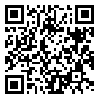BibTeX | RIS | EndNote | Medlars | ProCite | Reference Manager | RefWorks
Send citation to:
URL: http://salmandj.uswr.ac.ir/article-1-1340-en.html
2- Department of Psychology, Faculty of Humanities, Hamadan Branch, Islamic Azad University, Hamadan, Iran. ,
3- Department of Psychology, Faculty of Humanities, Malayer Branch, Islamic Azad University, Malayer, Iran.
4- Young Researchers Club, Hamadan Branch, Islamic Azad University, Hamadan, Iran.
Objectives Death Anxiety is prevalent among people, and it is more prominent in the middle and late stages of life. Furthermore, the increasing number of elderly and consequently, their growing residence in nursing homes have impacted their mental health. The prevalence rate of death anxiety in up to (16%)in people; while (3.3%) of them are suffering from severe types of it. The present study determined the relationship between the fear of death, and religious beliefs, as well as mental disorders in the elderly living in nursing homes.
Methods & Materials One-hundred elderly (61% females and 39% males), with the Mean±SD age of 70.88±8.93 years living in nursing homes in Karaj City, Iran were studied. They were non-randomly and voluntarily selected to participate in this correlational study. The research tools included Templer Death Anxiety Scale (DAS, 1970), SCL90 neurological, intellectual and emotional dysfunction inventory, and Golriz-Barahani religious attitude questionnaire. Furthermore, Pearson’s correlation and multiple regression techniques were adopted for data analysis. The obtained data were analyzed in SPSS.
Results The Mean±SD scores of death anxiety, religious beliefs, and mental disorders in the elderly population at nursing homes in Karaj were respectively 6.30±3.12, 16.04±3.88 and 99.51±57.96. No relationship was observed between death anxiety and religious beliefs. Additionally, Pearson’s correlation coefficient suggested a significant inverse relationship between religious beliefs, psychosis, and obsession. Furthermore, the findings suggested a significant correlation between the fear of death and religious beliefs in older adults with mental disorders. Moreover, the correlation coefficient between the fear of death and mental disorders was 0.499 (r=0.499, P<0.01); suggesting a significant correlation between these variables. Thus, the higher the death-anxiety level in the elderly, the more their mental disorders will be.
Conclusion It is possible to reduce the occurrence or intensification of mental disorders. This could be done by arranging and implementing psychological programs to diminish death anxiety in the elderly.
Received: 2017/05/12 | Accepted: 2017/12/24 | Published: 2019/07/31
| Rights and permissions | |
 |
This work is licensed under a Creative Commons Attribution-NonCommercial 4.0 International License. |








